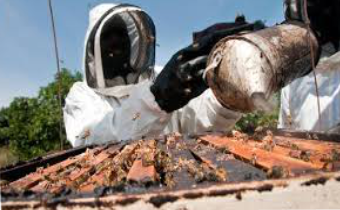 Traditionally practiced as a hobby with simple logs, bee keeping is emerging as a big business with farmers delving into commercial honey harvesting buoyed by burgeoning demand both locally and internationally. Farmers are now investing in modern hives built for high yield and easy harvesting.
Traditionally practiced as a hobby with simple logs, bee keeping is emerging as a big business with farmers delving into commercial honey harvesting buoyed by burgeoning demand both locally and internationally. Farmers are now investing in modern hives built for high yield and easy harvesting.
African Bee Keepers, supplier of the Langstroth commercial beehive, reports it sold over 8000 in 2012, up from 5000 in 2008. According to Managing Director Ernest Simeoni, a farmer can get 30kg per harvest from the Langstroth, roughly double the normal harvest from the swinging Kenya Top Bar hive and traditional log hives.
Harvesting from log or KTB hives results in almost all the colony and the queen being displaced, but the Langstroth remedies that through its two lower and upper super box partitions.
The lower box, the brooder, houses the queen and is separated by a mesh from the upper super box where worker bees make the honey. The mesh stops the queen accessing the super box, where she could lay eggs that could be destroyed in honey harvesting.
The honey combs themselves are taken out in the super box, which is immediately replaced with a new one, so bees can continue making honey. As each box is emptied of honey, with a centrifuge machine, the combs are left intact, to go back in with the next super-box change-over.
By recycling combs, bees make the honey faster in the next phase, as they don’t have to build new ones after every honey harvest.
Together, the partitioning of the Langstroth and harvesting with a centrifuge machine ensures bees are minimally disturbed.
“It’s a friendlier hive to the generally aggressive African Bee,” said Simeoni as colony disturbance is low. The traditional way of harvesting honey from other types of hives, leaves the colony scattered and often destroyed.
For dry regions like Ukambani where forage to make nectar is only present during rains, recycling of combs ensures bees can concentrate on making honey during the short-lived ideal conditions, rather than first collecting nectar to build combs.
Where combs are recycled and forage is plentiful, a bee keeper can harvest the 30kg of honey in four months as opposed to waiting almost a year. Some forage varieties African bees prefer are Croton, eucalyptus, coffee, oranges, bananas, acacia trees even the much maligned mathenge shrub rife in arid regions. Mathenge shrub has been blamed by pastoralists for making their goats toothless after eating it.
“The honey from each of them tastes different,” says Simeoni.
Like all hives in East Africa, where bees themselves are not commercially bred, bees only get into the hive by chance. “Nature controls that,” said Simeoni. But he advises they can be near forage flowers where bees gather.
After the colonies get in, the Langstroth is moved to an area clear of shadows but near a water source. “Lack of sunshine makes them lazy,” he adds. He advises the bees’ tiny opening to face to sunrise. As “the sun wakes them up in the morning”.
The hives are mounted on stands raised a metre from the ground and need to be tidy and clean. Termites and honey badgers are the main problems for bees and hives. Termites can be kept out by keeping the grass low and the badgers by securing the area or ensuring the one metres hive ground clearance.
Regular weekly supervision of hives is also recommended.
For general safety, Simeoni advises the hives be kept 300 metres from where people are living.
African Bee Keepers sells each hive at Sh4100 and a bees’ suit, which provides protection form stings when harvesting, for Sh4800. The centrifuge extraction kit is more expensive, however, at around Sh45,000.
In addition to selling the Langstroth hive, the company also trains farmers on managing the hive. They buy a kilogram of honey at Sh130 and the bees wax to make the honeycomb foundation sheet for new hives at Sh300 per kg. The hive lasts for eight years.
“Bee keeping is a low cost venture with high returns,” said Simeoni, who points out taht farmers can also process and pack their own honey in bottles that cost Sh12 with a label that costs Sh3. After packing, a bee keeper can sell half a kilogram of honey at Sh130 or more to clients.
Currently, African bee Keepers works with farmers in regions like Mwingi, Kibwezi, Sagana, Ruiru, Narok and Maasai Land. The farming is not just for dry regions. “Bee keeping fares far much better in the highlands where forage is ever in plenty all year,” said Simeoni.
The peak periods for honey production are during the short and long rains, when forage for nectar is plentiful.
To make the hives, African Bee Keepers buys legally farmed wood from small holder Farmers
















Comments powered by CComment